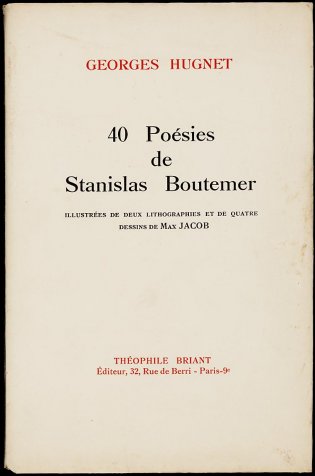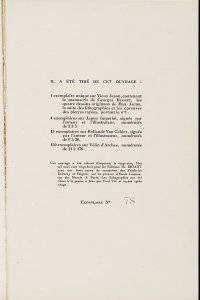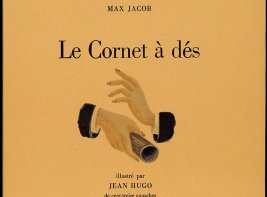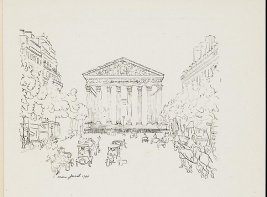40 Poésies de Stanislas Boutemer
Year: 1928
Author: Georges Hugnet (1906 - 1974)
Artist: Max Jacob (1876 - 1944)
Publisher: Théophile Briant
Friends in high places
Hugnet hadn’t published any work yet in 1928, but he had already met nearly all the major artists of his age. The collection was his debut. Hugnet was as versatile as Max Jacob: a painter, playwright, art critic, and essayist. He established a bookbinding company in 1934. He changed direction in 1940, becoming a book trader and the publisher of Tristan Tzara and Gertrude Stein, among others. In October 1940 he wrote and published the first resistance poem 'Non vouloir'. Another text by Hugnet was used in 1952 for the famous artist's book Les revenants futurs with etchings by Dutch illustrator Jean Paul Vroom. Hugnet is currently not well known as a writer or illustrator, but rather as the 'biographer' of the avant-garde movements dada and surrealism.
Hugnet was only sixteen years old when he met Max Jacob, but he was already very ambitious. And Jacob reacted as he did more often when a young writer tried to get in touch with him: he took him under his wing. He engaged in an intense correspondence with Michel Leiris and Edmond Jabès. He gave Georges Hugnet a boost by illustrating his debut with four drawings and two lithographs. He also introduced him to his circle of friends (including Francis Picabia, Max Ernst and André Salmon), and brought him into contact with authors who stimulated Hugnet's career (such as Jean Cocteau), and who influenced his work (such as Robert Desnos). Georges Hugnet found in Max Jacob a friend with not only artistic gifts, but also with an elaborate network.
Bibliographical description
Description: 40 Poésies de Stanislas Boutemer / Georges Hugnet ; ill. de deux lithographies et de quatre dessins de Max Jacob. - Paris : Théophile Briant, [1928]. - 80 p. : ill. ; 26 cm
Printer: Émile Lemaux (Paris) (text) Paul Vié (lithography)
Edition: 170 copies
This copy: Number 78 of 150 on Arches
Typeface: Type by Deberny and Peignot
Bibliography: Bénézit 7-412/413 ; Monod-6131
Shelfmark: KW Koopm L 495
References
- Pierre Andreu, Vie et mort de Max Jacob. Paris, La Table Ronde, 1982
- Gerald Kamber, Max Jacob and the poetics of cubism. Baltimore, The John Hopkins Press, 1971
- James Phillips, Georges Hugnet (1906-1974): 'le pantalon de la fauvette': de dictionnaire abrégé du surrealisme: étude et choix de textes. Paris, Lettres Modernes, 1991
- Christine van Rogger-Andreucci, Max Jacob: acrobate absolu. Seyssel, Champ Vallon, 1993

![40 Poésies de Stanislas Boutemer, litho door Max Jacob (pagina [5])](/sites/default/files/styles/galerie/public/images/40-poesies-de-stanislas-boutemer-p5.jpg?h=ff2f53f6&itok=hMkiJhRy)
![40 Poésies de Stanislas Boutemer, litho door Max Jacob (pagina [13])](/sites/default/files/styles/galerie/public/images/40-poesies-de-stanislas-boutemer-p13.jpg?h=922b2090&itok=cr2Operl)

![Fotocollage op pagina [103]](/sites/default/files/styles/gerelateerd_item_mob/public/images/huit-jours-a-trebaumec-p103.jpg?h=aa0faa14&itok=jrydMZv3)

